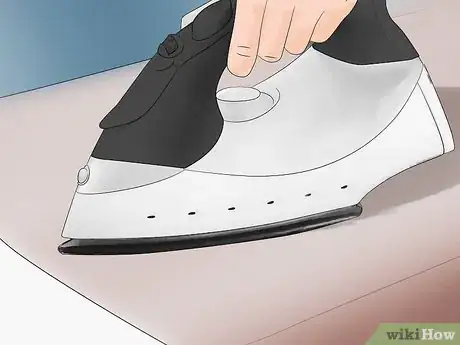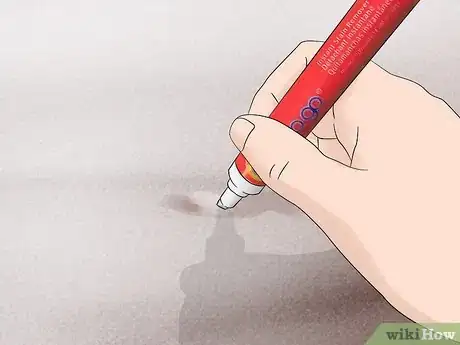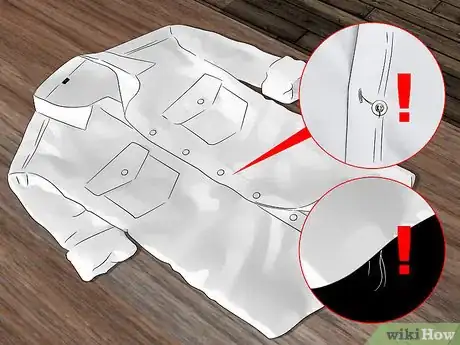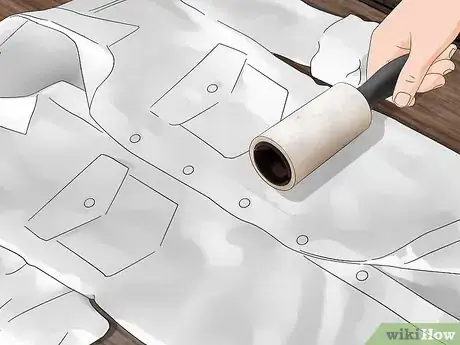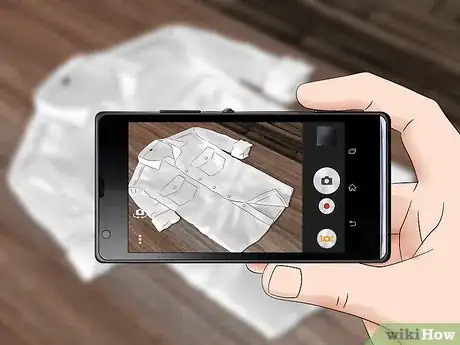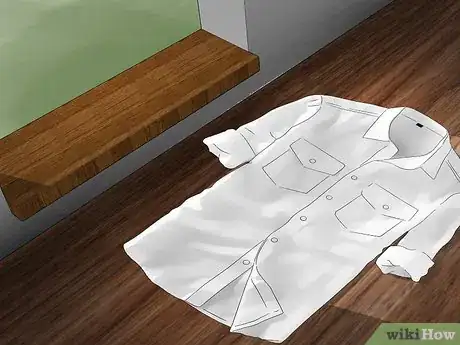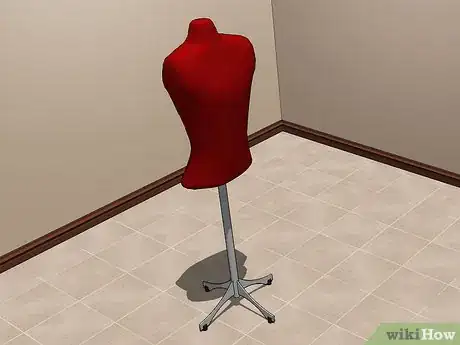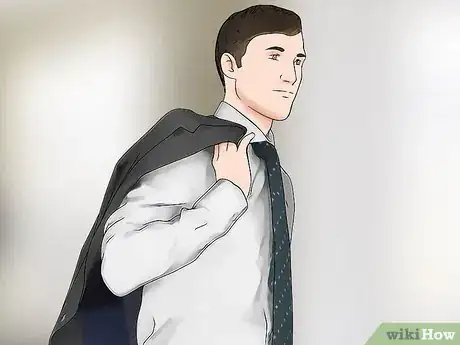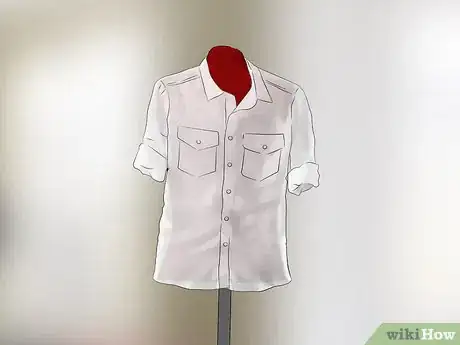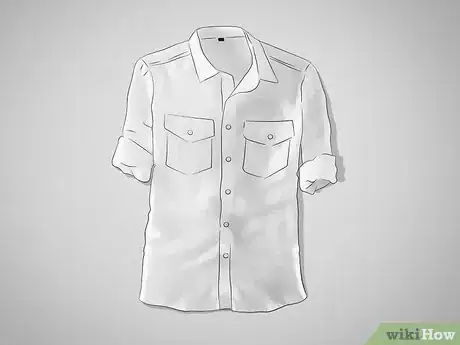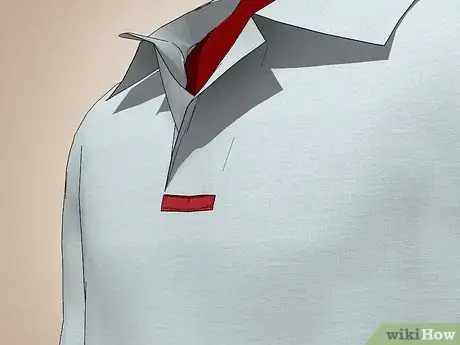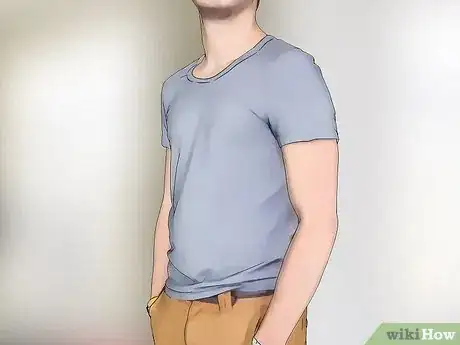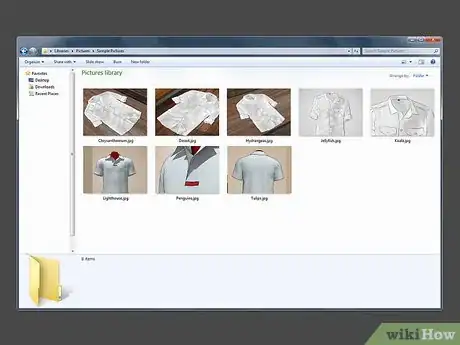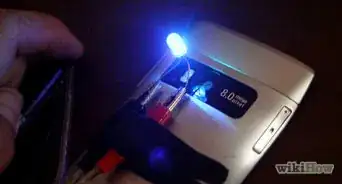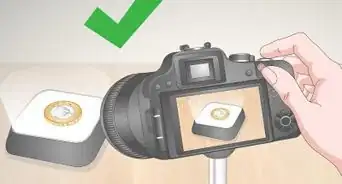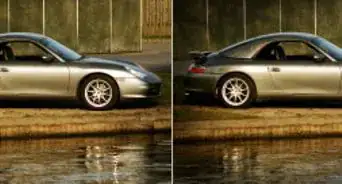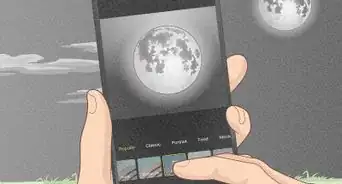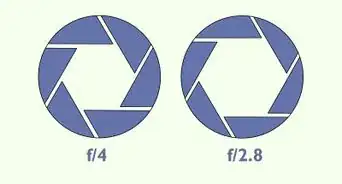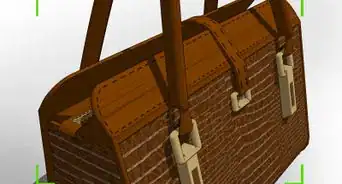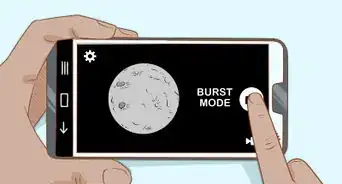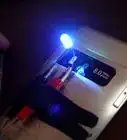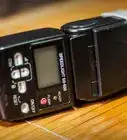This article was co-authored by Crystal Bear. Crystal Bear is a Professional Photographer and the Owner of Summer Bear Photography. Crystal specializes in weddings and portraits for women. She holds a BS in Interior Design and Consumer Science from San Francisco State University. Coming from a design background, Crystal brings a sense of style and artistry to her work that brings out her client’s inner confidence, showcases their beauty both inside and out, and puts them at ease. She also specializes in using the correct lighting and branding for women entrepreneurs.
There are 9 references cited in this article, which can be found at the bottom of the page.
This article has been viewed 106,161 times.
Great photos are the best way to show off clothes for sale to potential customers. Start by steaming and lint-rolling the clothes to make them look their best, then showcase them with a mannequin, model, or flat lay format. Use a light backdrop, bright lighting, and lots of different angles to capture the colors and details of each garment. With the right tools and a little hard work, you can get beautiful product photos that are sure to draw in sales!
Steps
Making the Clothes Look Their Best
-
1Steam or iron the clothes to get rid of any creases and wrinkles. Hang up the clothes and use a small handheld steamer to smooth out creases in the fabric.[1] Smooth, wrinkle-free clothes will look much more polished and appealing to customers.
-
2Remove any stains from the clothes. If you can easily get the stains out yourself with bleach or a Tide pen, remove stains yourself. However, if the clothing is delicate or difficult to clean, take it to a dry-cleaner to have any stains removed.
- If the article of clothing has very minor staining, it may not be worth it to pay for dry-cleaning. Instead, you could reduce the price accordingly, be upfront about stains, photograph them well, and let the buyer handle removal.
- This is especially important with vintage or antique clothes, which can be fragile and easily damaged.
Advertisement -
3Inspect the clothing closely for other flaws. Look over each piece for issues such as loose threads, missing buttons, rips, or broken zippers. You can fix most of these small problems yourself buy trimming hanging threads or sewing matching buttons back on. However, issues like broken zippers or major rips are not as easily fixed.
- Document any un-fixable issues in your listing and be upfront with the buyer when you sell the garment.
-
4Use a lint roller to remove any dust, hair, lint, or stray threads. Any little specks and spots that show up in the photos will distract customers and look unprofessional. Take extra care to remove these before you start photographing. Lint-roll the whole garment once, then spot-check it once it’s in position to be photographed.
Setting up Your Equipment
-
1Use your smartphone for a quick, inexpensive option. With bright, natural lighting, smartphone pictures can look great and get the job done. Position the garment next to a bright window and use your back-facing camera to frame it. Focus on the garment and adjust the lighting, then take several pictures.
-
2Use a DSLR (Digital Single Lens Reflex) camera if you have access to one. Taking photos with a DSLR will make your listings look even more professional and higher-quality. A higher megapixel count will be able to capture the color and details of the garment more accurately. Make sure you use the correct settings to get the best photos possible.[2]
- Set your ISO at no higher than 600-640 to prevent graininess.
- Set your aperture higher than F/11 to keep all the details of the garment in focus.
- Select a white balance according to the type of light source you’re using. The most common settings are natural sunlight, tungsten, fluorescent, and LED.
-
3Photograph the clothing you wish to sell indoors against a white or light grey backdrop. This will help keep the lighting consistent, prevent distractions, and ensure that the colors are captured accurately. You could use a white wall or a smooth sheet, or for a little more money, you could purchase a roll of seamless paper from a photography store.[3]
- Always stand the model or mannequin in the center of the backdrop, directly in front of your camera.
- If you have a c-stand, use it to hold the seamless paper backdrop in place. If you don’t have one, just tape the end of the paper to the wall or ceiling.
-
4Take photos next to a window for nice, natural light. This type of lighting brings out vibrant colors, looks relaxing and appealing to customers, and won't cost you a thing. Set up your backdrop and mannequin, model, or Flat Lay area in an area next to a bright, open window. Shoot during the morning and late afternoon for the most even indirect light.[4]
-
5Rent or invest in a simple lighting kit for a more professional effect. You can find inexpensive beginner kits online for reasonable prices. The most important piece to have is a large softbox, which creates diffused, even light and softens shadows.[5] Professional lighting is best for taking catalogue photos or documenting a full clothing collection.
- If you will be selling clothes often or professionally, a lighting kit is a must.
- A simple lighting setup includes a light head, softbox, c-stand, battery pack, and pocket wizard.
- You can buy lighting kits on sites such as https://www.amazon.com or https://www.bestbuy.com, or you can rent from sites like https://www.csirentals.com.
Displaying the Clothes
-
1Purchase a mannequin for a convenient, cost-efficient option. Mannequins are a good investment that can help provide consistency to your photos and keep your budget low in the future.[6] You can set up the mannequin and take pictures at any time without having to pay or schedule a model. Mannequins also let customers visualize themselves wearing the clothes.[7]
- You could purchase a standing, full-body dress mannequin, or you could also get a set of hollow-backed partial mannequin bodies. These also come in sets that include a male, female, and gender-neutral child mannequin.[8]
- Clothes that work best with mannequins include jeans, blazers, long dresses, coats, and blazers.[9]
- Unless you’re selling mostly strapless items, make sure to purchase mannequins with arms that can fill out sleeves.[10]
-
2Hire a model if you have enough of a budget to do so. Seeing the clothes on the model gives the customer a better idea of what the clothes will look like in real life. A good model can also more clearly appeal to your target market. For example, if you’re selling your clothes with teenagers in mind, having a teen model will draw in teens and help them imagine how it would look on them.[11]
- You could also ask a friend to help you out with the modeling.
- To save money, use a mannequin or dummy for the basic side, front, back, and close-up detail shots, and use the model to show what the article of clothing looks like when it’s paired with an outfit.[12]
- If you go with a model, remember that the focus of your shoot should be the clothes, not the model wearing them.[13]
- Check out popular fashion magazines like Vogue for inspiration to help you come up with good ways for the model to pose.[14]
-
3Pin and tuck the clothing until it fits the model or mannequin. Use pins and clips to pull in waistlines or adjust straps, and use magic tape to hold down any gaping armholes. Of course, you shouldn’t alter the clothing to the point that it doesn’t look like the original garment, but you want to show the best fit possible.[15]
- This is especially important it your mannequin has a hollow back and cannot fill out the clothing properly.
-
4Use flat lay photos to showcase the item in a simple, clean way. You can easily create a flat lay photo by laying out and arranging an article of clothing on a flat background, then shooting straight down at the garment. To add the illusion of depth to the clothes, use techniques such as tucking in fabric around the underarm area or adding tissue paper inside the clothes.[16]
- The flat lay format works best with skirts, sweaters, shoes, scarves, handbags, towels, and kids wear.
- If you don’t have the budget for a model or a mannequin, this technique is a simple, affordable alternative.
Taking the Photos
-
1Take photos from the back, side, and front of the garments. Be thorough as you document each piece. If you’re using a mannequin, rotate it in front of the background and take photos from each different angle. If you’re hiring a model, have them turn slowly and take a series of photos showing each angle. The more thorough you are, the more likely people are to purchase the clothes you’re selling.
-
2Get up close to show details in the clothing. Customers want the experience of being able to pick something up and get a closer look at it, even while shopping online. Imitate this experience by getting close-ups of the fabric texture, buttons, tags, delicate stitching, and patterns. Use lots of different angles and close-ups to let the customer feel like they’re getting the full picture.[17]
-
3Take photos of any tags, instructions, and flaws on used clothing. If you’re selling used clothing, you’ll need to provide extra information about each piece. Document the brand name, any tags that show that the clothing has never been worn, and wash/care instructions. You should also take clear photos of any imperfections in the clothing, such as stains, rips, or tears.
- Customers will trust you much more as a buyer when you provide clear, upfront information about the garments.
-
4Take pictures of different poses that showcase the clothing. If you hire a model, have them try several different poses for each outfit, such as a hand behind their head or with their hands in their pockets. Make sure the poses you’re using don’t cover up too much of the product with accessories or hands.[18]
- For example, if you’re photographing a flowy dress, you could have the model hold out the sides of the dress to show off the fabric.
- If you’re photographing a men’s winter jacket, you could have the model turn slightly to the side and put his hands in the pockets.
- Avoid sitting, jump shots, or motion shots that might blur or distract from the garment itself.
-
5Sort through your photos and choose the best ones for your listings. Once you’ve transferred your photos onto a computer or device, look through all of the photos and delete any that are blurry or too dark. Pick several of the best photos for each garment listing, including 1 shot from each of the front, back, and side angles, as well as a close-up shot that shows the garment’s texture.
- If you’re selling new clothes, you should also include a photo of a model wearing the piece as part of an outfit.
- If you’re selling used clothes, add several photos of tags, care instructions, or imperfections.
Expert Q&A
Did you know you can get expert answers for this article?
Unlock expert answers by supporting wikiHow
-
QuestionHow do I photograph shoes and accessories?
 Crystal BearCrystal Bear is a Professional Photographer and the Owner of Summer Bear Photography. Crystal specializes in weddings and portraits for women. She holds a BS in Interior Design and Consumer Science from San Francisco State University. Coming from a design background, Crystal brings a sense of style and artistry to her work that brings out her client’s inner confidence, showcases their beauty both inside and out, and puts them at ease. She also specializes in using the correct lighting and branding for women entrepreneurs.
Crystal BearCrystal Bear is a Professional Photographer and the Owner of Summer Bear Photography. Crystal specializes in weddings and portraits for women. She holds a BS in Interior Design and Consumer Science from San Francisco State University. Coming from a design background, Crystal brings a sense of style and artistry to her work that brings out her client’s inner confidence, showcases their beauty both inside and out, and puts them at ease. She also specializes in using the correct lighting and branding for women entrepreneurs.
Professional Photographer
-
QuestionIs eBay a good stepping stone selling vintage clothes until I have a website?
 Community AnswerFor sure; any resale site will work great.
Community AnswerFor sure; any resale site will work great.
References
- ↑ https://pixc.com/blog/how-to-take-photos-of-clothing-for-your-online-store/
- ↑ https://www.shopify.com/blog/55892613-7-steps-to-beautiful-diy-apparel-product-photography
- ↑ https://www.shopify.com/blog/55892613-7-steps-to-beautiful-diy-apparel-product-photography
- ↑ http://www.steves-digicams.com/knowledge-center/how-tos/photography-tips/how-to-use-natural-light-in-fashion-photography.html#b
- ↑ http://www.tabletopstudio.com/documents/clothing_photography.htm
- ↑ https://pixc.com/blog/how-to-take-photos-of-clothing-for-your-online-store/
- ↑ Crystal Bear. Professional Photographer. Expert Interview. 21 January 2021.
- ↑ https://youtu.be/uVVmT7AWICQ?t=307
- ↑ http://styleshoots.com/blog/2016/11/flat-lay-or-invisible-man-a-guide-to-choosing-the-right-product-photography-for-fashion
- ↑ https://pixc.com/blog/how-to-take-photos-of-clothing-for-your-online-store/
- ↑ http://styleshoots.com/blog/2016/11/flat-lay-or-invisible-man-a-guide-to-choosing-the-right-product-photography-for-fashion
- ↑ https://pixc.com/blog/how-to-take-photos-of-clothing-for-your-online-store/
- ↑ Crystal Bear. Professional Photographer. Expert Interview. 21 January 2021.
- ↑ Crystal Bear. Professional Photographer. Expert Interview. 21 January 2021.
- ↑ https://pixc.com/blog/how-to-take-photos-of-clothing-for-your-online-store/
- ↑ http://styleshoots.com/product-photography-tutorial/2016/5/5-tips-on-how-to-style-a-shirt-flat-lay-for-your-web-store
- ↑ https://youtu.be/uVVmT7AWICQ?t=507
- ↑ https://pixc.com/blog/how-to-take-photos-of-clothing-for-your-online-store/
About This Article
Taking good photographs of your clothes for sale is important since it makes your items look better and can draw in more customers. To take good photographs, you’ll want to use a backdrop and have good lighting. Try using a white wall or a plain sheet as a backdrop. Alternatively, purchase a roll of seamless paper from a photography store. If you don’t want to buy lighting, take your photos next to a window on a sunny day. Or, invest in a beginner lighting kit. Using a mannequin is the most cost-effective way to display your clothing, but you could also hire a model or even ask a friend to model the clothes for you. Make sure to take photos from several different angles so customers get a good idea of what the clothing looks like. You may also want to take close up photos of any intricate details and the tag on the inside. To learn how to get older clothes looking their best, read on!
